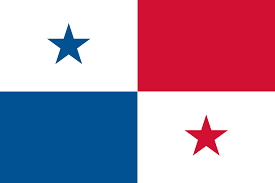
PANAMA
Trackchasing Country #73
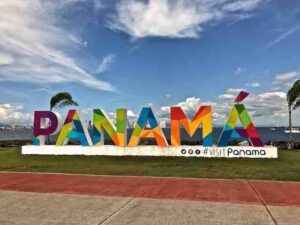
PANAMA
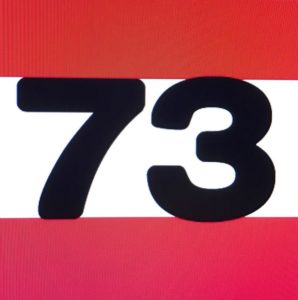
Trackchasing Country #73
Greetings from places on the way to La Chorrera, Panama. Click on the links below to read about the “story” and see the photos and videos from a fine trip to Panama, trackchasing country #73.
LIKE TO KNOW MORE ABOUT PANAMA – TRACKCHASING COUNTRY #73?
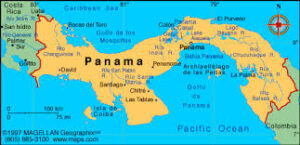
As a service to my readers I always provide a top line overview of each country I visit. If you’d like to learn a little more about the Central American nation of Panama check out the “background” information I prepared for you. It appears at the bottom of this report. I have condensed this section so you can get a good “feel” for this unique location. Most of the material comes from Wikipedia.
PRE-TRIP
Advance Preparation
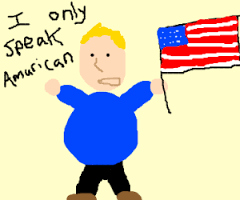
THE RACE
In some countries the language barrier prevents me from getting as much advance information as I would like. That was the case with Spanish-speaking Panama. Many folks, whose first language is something other than English, don’t feel comfortable carrying on a written conversation in English .
Despite taking two years of high school Spanish (which I barely passed) and living in Southern California my Spanish speaking skills are almost zero. I had some difficulty getting the travel and logistics information I was looking for. Later in the process the situation improved greatly.
Racing on a circuit track has just resumed in Panama on a new track named Circuito Internacional de Panama. From what I could tell they race cars there about once every three months. They also race motorcycles and have drag racing.
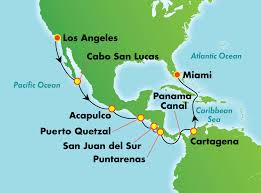
Getting There
My initial plan was to fly standby from Los Angeles to Panama City, Panama. That’s how I get most places. I had all kinds of arrangements planned in Panama. I had a private driver lined up. Our hotel reservations were made. I had city tours scheduled.
If YOU were taking a long trip like this, more than 6,000 flying miles would you be willing to fly “standby”? That could mean that if the plane was full you would be standing in the vacant airline terminal waving good-bye to everyone going on THEIR Panamanian vacation. Don’t worry. It’s how I roll.
THE VISA
No visa needed for U.S. residents. I would cruise in with my U.S. passport and all would be rosy. I must tell you this. I never go anywhere without a plan. I can develop a plan in a micro second. However, I also know that regardless of how much I plan something or a few things will go wrong. That’s when I earn my money. When stuff goes bad I have to have a backup plan so more stuff doesn’t go bad.
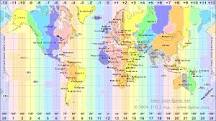
TIME ZONES
The time zone difference wasn’t much from California to Panama. Panama is in the Eastern Standard Time Zone. That’s means they are five hours behind Coordinated Universal Time (UTC). Another way of looking at it is they have the same time as the U.S. east coast. A three hour time difference from California would be easy to handle.
BOOTS ON THE GROUND
I have some proprietary technology advantages over my trackchasing fellow competitors. Due to the competitiveness of this hobby I can’t really share these advantages. You can appreciate that right?
I had several people in Panama helping me. For that I am eternally grateful. Making these long trips can be done without help. However, a trip will not be nearly as fulfilling with little local help.
I want to organize my own trips. However, before I can do that I seek out the advice of all of the locals. Some trackchasers are quite comfortable landing at the airport, having their host pick them up and drive them everywhere. Then at the end of the trip the hosts drops them back at the airport. Trip completed.
I DO NOT want to travel like that. I want to decide where I stay, what I see, when I stop and everything else. Don’t get me wrong. It’s extremely important to get the advice of anyone who has more knowledge than me about where I’m traveling. However, after all of the advice seeking is complete I make the decisions.
THE TRANSPORTATION
In a way, if everything worked, this would be a rather simple logistical trip. I was hoping to fly non-stop. Once on the ground I would employ a series of private drivers. In a busy place like Panama City I was advised that professional drivers would be faster, safer and maybe even less expensive than renting a car. I might even use Uber.
However, when I researched rental cars on Kayak.com I saw prices from major rental car companies in the $4-5/day range! Wow! I suspected that those companies would make up the difference by requiring that their insurance be bought. That’s what happened to me in Ireland.
On the other hand if the non-stop flight opportunity faded away we would be connecting somewhere in the U.S. During the planning stages I didn’t want to give much thought to that. I was hoping to make the non-stop flight.
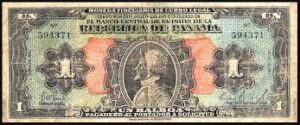
CURRENCY
The official currency in Panama is the “Balboa”. One Balboa equals one U.S. dollar. That would make things easy. The U.S. dollar is the most commonly used currency in Panama. That started in 1904 when Panama ceded from Colombia. Panamanian coins come in the same denomination and dimensions as U.S. coins. There are no paper Balboas.
WEATHER
Hot and rainy. Temperatures would be in the high 80s with humidity. That’s a lot warmer, for December, than anywhere in the continental U.S. I was counting on the races being held rain or shine.
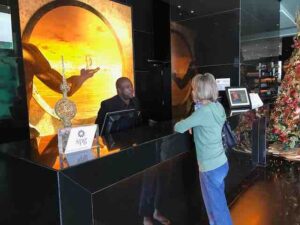
OVERNIGHT ACCOMMODATIONS
If you’re going to travel internationally then it’s nice to stay in upscale accommodations. On this trip the Le Meridian hotel was selected. It’s a opulent hotel located on the beach and close to fantastic restaurants. This would be a great place to hang my hat for four nights.
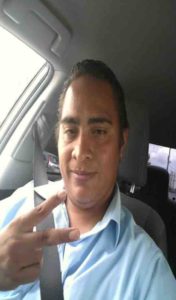
THE RENTAL CAR
No rental car needed on this trip. I’ll be going with private drivers, Uber and maybe the subway. I like having a rental car in foreign countries where there is a lot of rural driving. It’s a great way to see the country. However, in very busy foreign cities it is best to let someone else do the driving. As you can see from reading the story I discovered, almost by accident, the services of one Camilo Bermudez. He would be our driver, tour guide, translator and friend.
NAVIGATION
When someone else does the driving I don’t need to worry about navigation systems. That’s another reason for having drivers.
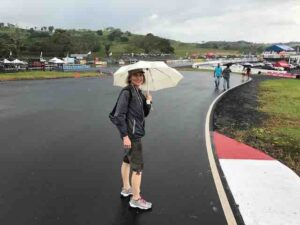
THE TRAVELING COMPANION
I am most pleased to tell you that Carol is coming along on this trip. She will be in search of her 41st trackchasing country. It took a pretty good selling job for me to convince her to leave home in December. That month is probably her busiest of the year. However, given what I have planned for much of the rest of December she agreed to come along.
When Carol comes along on any trip the accommodations get upgraded, the restaurants are better….everything’s better. She doesn’t ask for the upgrades. She just deserves them.
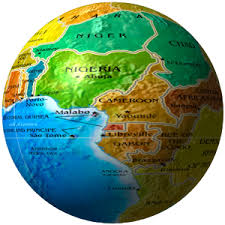
THE SUMMARY
My “world trackchasing map” has filled up surprisingly quickly. Coming into Panama I had seen racing in 72 countries. Growing up in the small factory-based town of East Peoria, Illinois I had absolutely no idea I would someday travel the world. I’ve met a lot of nice people, seen the sights of the world and dined in the very best restaurants. Without my hobby of trackchasing I don’t think I would have been motivated to do that.
So how did THIS trip really come down?
Foreword
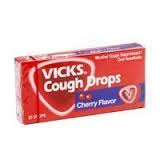
I travel a lot. Up until I was 23 years old I didn’t travel virtually at all. Then following boot camp in the United States Marine Corps I got a job selling cough drops (other stuff too). From the age of twenty-three I have flown on an airplane virtually every week of my life up to this point. That’s saying something considering I didn’t fly on my FIRST airplane until I was twenty-one.
If you’re going to travel, and enjoy it, you had better have a flexible mindset. I like to say that I am “comfortable with ambiguity”. That simply means I can go with the flow. Yes, I like to control the flow but understand when it is required to GO with the flow. Travel encourages you to do that.

One of the things that Carol and I learned early in our marriage was that family celebrations needed to be fit in around business commitments. The company wasn’t going to schedule the national sales meeting around our birthdays, wedding anniversaries and the like. That was O.K. They sent us some pretty big checks until I retired at the age of fifty-three. Yes, I worked for money for 30 years following college graduation. When you work for money others pick the songs.
It’s pretty obvious that I wouldn’t travel if I didn’t want to. No one puts a gun to my head to do this. I travel because I am intrigued with what is on the other side of the mountain. For this trip the country of Panama was on the other side of that mountain.
Nevertheless, despite a thorough planning process, the trip never goes 100% according to plan. Some things just don’t work. Other better ideas come along after we hit the ground. However, in the end, we always have a good trip and coming to Panama was no exception.
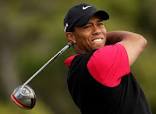
My stories begin from the time we leave home and end at the moment we get back to our driveway. I write these stories so that my trackchasing fellow competitors can simply follow my plan. Of course, that’s a little bit like Tiger Woods telling me “just hit it down the fairways 320 yards”. If it was easy everyone would try to do this. It’s not easy so no one does it the way I do it.
Wednesday – November 30, 2016
In order to make both this trip work and the one that immediately follows it we would have to celebrate Carol’s birthday a few days early. She was fine with that. I was fine with that.
We would celebrate by “driving into LA”. That’s what you say when you live in San Clemente. You “drive into LA”. What would we do in Los Angeles? It was sort of a “dinner and a movie” play date.
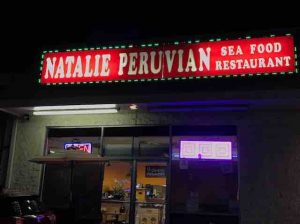
We started out with a visit to Natalie’s Peruvian Seafood restaurant. We’ve been here several times. It’s our favorite Peruvian restaurant by a mile. The place is small. It doesn’t seat more than about twenty people. Normally, it’s not very crowded. Yelp gives it a solid 4-star rating.
Tonight we dined on dry fried corn (above), squid, noodles, fried rice and French bread covered with Natalie’s special spicy green sauce. It was delicious. We had enough left over to make a tasty breakfast treat for tomorrow morning.
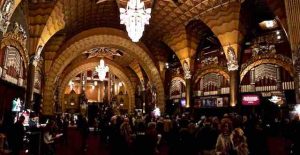
Following dinner was our “movie”. O.K, it really wasn’t a movie but a Broadway production of Irving Berlin’s “White Christmas”. It was being performed at the beautifully ostentatious Pantages Theater. The Pantages Theatre was built it 1930 for vaudeville performances. From 1950-1960 the Pantages was home to the Academy Awards ceremonies.
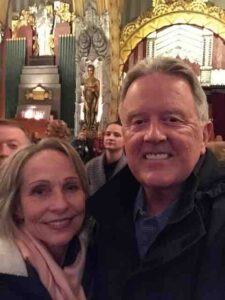
The show was wonderful. Normally, I’m not that much into musicals but White Christmas had a good story line as well. I had purchased our tickets months ago. We had great seats in the playhouse that had sold out all 2,703 seats. This was a fantastic way to celebrate Carol’s birthday.
From the play we headed over toward LAX (Los Angeles International Airport). There we had a Priceline.com secured Extended Stay America hotel reserved. Yes, Priceline had saved us $47 over the best AAA rate available. Remember, as you can read from the above, I’m not interested in buying cheap things cheap. I want to buy good things cheap.
Why were we staying in a hotel tonight rather than driving back home? It was simple logistics. We had an 8 a.m. flight tomorrow morning to Miami. We would connect there to a flight that would take us to Panama City, Panama.
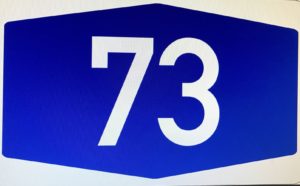
I was expecting Panama to be my 73rd trackchasing country. If that happens, it will happen on Sunday. By arriving on Thursday we will have two full days to tour in advance of the race. The biggest aspect of every international trackchasing trip is the sightseeing and people meeting. The racing comes behind that.
Thursday – December 1, 2016
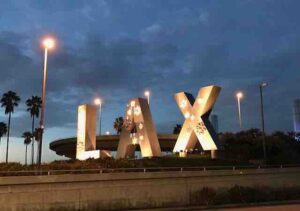
We were up early to catch our 8 a.m. flight to Miami and later to Panama City. Our car was parked at the airport with my long-time airport parking sponsor, LAX World Parking. American Airlines had given both Carol and I a full airline sponsorship to Panama. We couldn’t do much of this without sponsorship.
We’ll come home on Monday. If that all goes well I will head out on Tuesday in search of trackchasing country #74. Trackchasing country #74 was supposed to be trackchasing country #73. That was until Panama popped up on my international radar.
This is often the case with my travel planning. I might have something planned for the first day of the month. Then maybe I have something planned for the 10th day of the month. All the while I’m thinking I have nine days in between to relax and veg out.
That was sort of the case with this trip. Carol and I had our theater trip (a birthday surprise for her) planned for November 30. I was leaving on an international trackchasing trip on December 6.
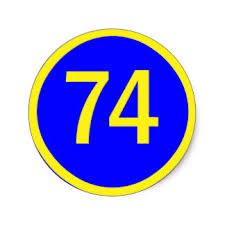
That was all fine until a Panamanian trackchasing/travel opportunity came up. Now we would leave for Panama on December 1 and return to Los Angeles on December 5. Now I had NO leeway between Carol’s birthday trip and what would now be trackchasing country #74 on December 6.
I almost always get loads of travel advice from local people before I finalize an international travel plan. That was the case with Panama. I got some, but not as much as usual, from TripAdvisor. The rest came local people I met on the internet.
Not many trackchasers travel internationally. Currently, I am the only trackchaser that makes trips to new countries and does my own planning. Some others go on these trips but they simply land in the new country, are picked up by a driver and chauffeured around the place until it is time to be dropped off back at the airport. I don’t travel that way.
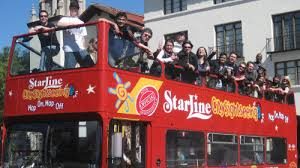
For almost every international trackchasing trip, or leisure trip for that matter, I do every bit of research myself. There have been a couple of exceptions. Carol and I traveled to both Russia and China, separate trips, as part of a small tour group. Those were wonderful trips. We met special people who we have remained in contact with for many years. However, that is not our normal mode of travel.
We’re in most foreign countries for 7-10 days, sometimes more and sometimes less. The trackchasing opportunity is what brings us to a particular country. However, the actual time at the racetrack will commonly be just 4-6 hours of the entire trip. That would be the case in Panama.
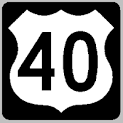
Up to this point I have seen racing in 72 countries. Carol’s total is 40 countries. However, if I had to estimate, we have made in excess of 100 foreign trips that didn’t have anything whatsoever to do with racing. Yes, we travel a lot.
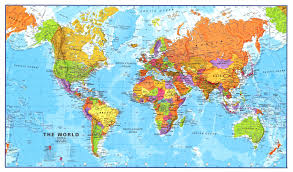
My research tells me there are 195 “countries” in the world. Of course, not all of them feature auto racing. It is getting more and more difficult to find new countries to visit where I could add racing to my list.
The person with the second most trackchasing countries is Roland Vanden Eynde of Belgium. Roland has seen racing in 52 countries. That’s puts “Trackchasing’s First Mother” also known as wife Carol in third place with her forty trackchasing countries.
I normally do a good deal of research about the racing and the touring in each country I plan to visit….before I visit. With Panama I would say I easily conversed, all on the internet, with more than 50 different people.
One of the bigger challenges in doing this is that I only speak English. As you can imagine most foreign countries do not use English as their primary language. However, sooner or later I end up finding people who can give me just enough information, in English, that I can piece the puzzle together. I have never had much luck with language translators although I have tried to use them.
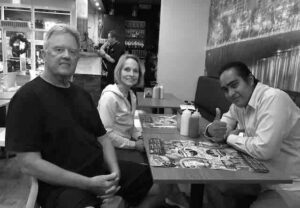
I ran into two fellows that helped me the most. The first was Camilo Bermudez. I first “met” him on TripAdvisor. I was considering different hotels in Panama. He answered my questions about location and quality of the places where we might be staying.
After several conversations with Camilo he made me an offer I couldn’t refuse. He told me “he liked races”. The racetrack was located about 50 kilometers (30 miles) from our hotel location in Panama City.
I didn’t plan on renting a car in Panama. With the track so close to the city, and with most of our touring being close by as well, my plan was to hire a driver. I’ve done that in several countries including Russia, India, Sri Lanka and Indonesia to name a few. I prefer to rent a car but sometimes it’s just easier, and less expensive, to go with a driver.
Camilo’s offer was simple. If I would pay for the gas, his race ticket and food and drink he would drive Carol and me to the track and back. From my best estimates I figured hiring a driver would cost a minimum of $100 U.S. I liked Camilo’s idea.
He and I would continue to talk on line. The more we talked the more confidence I gained in him. We would end up hiring Camilo to pick us up at the airport and take us on a five-hour tour of Panama City. If you need a driver or an organizer of local Panamanian activists then Camilo is your guy. Send me an email and I’ll put you in touch with him. Camilo made our trip with his skills and local understanding of Panama.
Carol and I would be staying at the Le Meridian in Panama City. I wish you could see and experience all of the different places I’ve stayed at on these trips. They run the gamut!
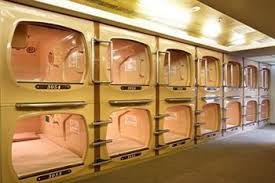
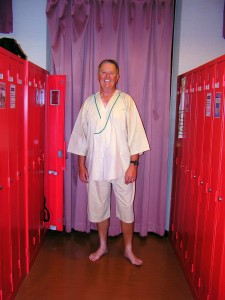
I’ve stayed in a “capsule” hotel in Tokyo, Japan. That was the most unique hotel experience I’ve ever had. Remember, that statement comes from a person who has stayed more than 5,000 nights in hotels. The photo above was when I had a golf tan and a watch! I once stayed in a “transit” hotel in Manila, Philippines. That room was probably six feet wide and maybe 12-15 feet long. It was within feet of the customs control point in the airport.
However, virtually every one of my really “unique” hotel stays have been when I traveled without Carol. When she comes along I feel compelled to go more of the luxury route. She doesn’t demand that treatment; she just deserves that treatment.
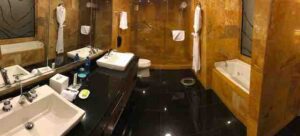
The Le Meridian was going to be an “opulent” hotel. I once heard another trackchaser say that he wouldn’t be staying in a foreign hotel with his wife because it was too “opulent”. Folks, there isn’t a hotel in the world that is TOO opulent for my wife. However, there are lots of hotels that are too expensive for my retiree budget. I wouldn’t say something was too “opulent” if I meant it was too expensive. I do my very best to say exactly what I mean.
We flew down to Miami and then Panama on American Airlines. During my 30-years business career I flew more than six million miles on AA. In reality, it didn’t take me thirty years to do that. American started their frequent flyer program in 1981. I retired in 2002. I guess it “only” took me twenty-one years to fly six million miles with American. I estimate that my combined airline mileage during this time frame on other airlines was also about six million miles. Since I retired I’ve flown more than two million MORE miles. I’ve spent some time on airplanes.
In planning this trip I developed a very extensive messaging system with my new friends from Panama. While I was sitting on the plane waiting to leave Miami I got a message. A friend, Alberto, a member of one of the Panamanian racing teams had secured pit passes for Carol and me. What a nice gesture. We agreed to meet tomorrow night for a drink at the hotel. He would give me the tickets then.
Then I got a message from Camilo, who was going to be our driver for much of the weekend. He told me not to worry if our flight was delayed. He was on the case. He was “tracking” our flight and would be there no matter how late we landed.
Another fellow by the name of Omar had given me all kinds of information about the race weekend. His English and understanding of what I was up to was impeccable. Ruben had jumped into the information sharing fray as well. He was giving me his recommendations on the best places to watch the race.
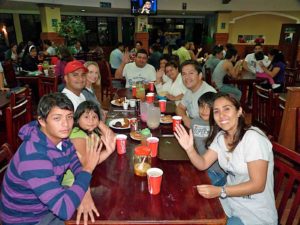
I have had some very friendly and impressive help when I have trackchased in Central and South America. I think of Costa Rica, Colombia, El Salvador, Guatemala and Peru just to name a few. The people in those places invited Carol and me to dine with their friends and family in local restaurants. They created banners announcing my arrival. They set up radio interviews with local media outlets. I even met an Englishman with a Russian wife who toured Argentina with me. Then when the Englishman switched wives his new Brazilian spouse had Carol and me over to the house for dinner in their Brazilian apartment. Yes, trackchasing has brought so many memories my way over the years. I am blessed. I was hoping for more of the same from Panama.
We landed in Panama at nearly 10 p.m. Clearing customs took about five minutes. Both Carol and I had to have our picture taken as well as our finger prints. Then we got another stamp in our bulging passports.
My driver for the trip, Camilo, was there to take us to the Le Meridian hotel. It was warm and humid befitting this near the equator climate. It was nice to meet Camilo’s wife who had come along for the ride.
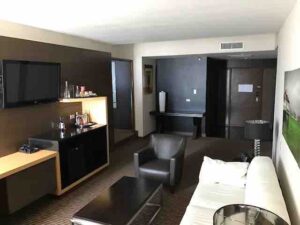
Traffic was light at this hour of night. When we checked into the Le Meridian we were upgraded to a suite, which was a reward for my platinum status in the Starwood Preferred hotel group. Our room came with complimentary breakfast in the morning and a very upscale happy hour each evening.
We had left our Los Angeles based hotel at 5:45 a.m. local time. Now we were going to bed in a luxury hotel in Panama City, Panama at nearly midnight. I love jet airplanes.
Friday – December 2, 2016
After a full day of cross country travel it was nice to be able to sleep in this morning until 8:30 a.m. We’ve got a great deal at the Le Meridian hotel in downtown Panama City.
Breakfast is included in our rate. It’s a breakfast buffet served in a beautiful atmosphere. We won’t go hungry here.
Camilo, was waiting for us as planned right outside the hotel at 11 a.m. Our plan was to tour Panama City for 5-6 hours.
I really like having a personal driver to show us around. We can start when we want to, go at our own pace and stop wherever and whenever we want. It really is the best way to go and often times costs less than a structured non-flexible tour.
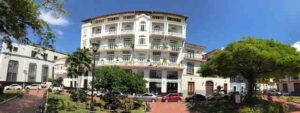
We started in “old town”. The old town section of most places we visit is always a highlight. Camilo was there to give us all of the background and answer our questions. We walked inside several beautiful churches. I got a Panamanian souvenir as well. I bought a used Panamanian license plate. It will go on my office bookshelf (that Carol keeps organized) as a remembrance of this trip. The asking price was $5 U.S. I couldn’t help myself and instinctively offered the seller three dollars. Without batting an eyelash, as my mother used to say, he accepted my offer.
I’ve got to tell you that Panama is much better than what we were expecting. I was thinking it would be a “third world” country like Mexico. Nope. Panama looks a lot like Bermuda. Of course, that’s a complement.
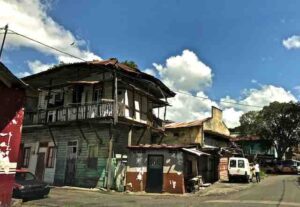
As mentioned I like having my own private tour guide. I will often ask, as I did today, if we can tour a low-income slum area. Camilo was quick to oblige. He drove us through the famous “El Chorrillo” neighborhood. Camilo told us this was not so bad during the day but would be much more dangerous at night. He also reminded me not to lower the window to take pictures! Boxer Roberto Duran grew up here. Actually, El Chorrillo didn’t look anywhere as bad as the slums of Jakarta, Indonesia were when I visited there. Jakarta ranks #1 in that category in my book.
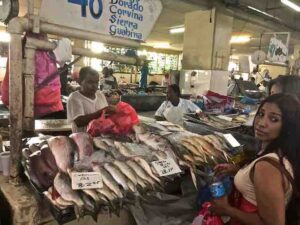
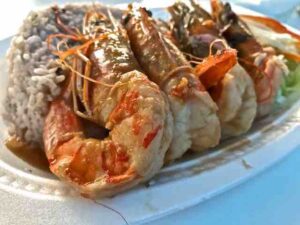
Next up was lunch at the Panamanian fish market. Cervice is a popular dish here. I dined on coconut rice and the very biggest “jumbo prawns” known to mankind. Huge at President elect Trump would say! After lunch we toured the indoor fish market, which was just winding down for the day. They had a lot of fresh fish!
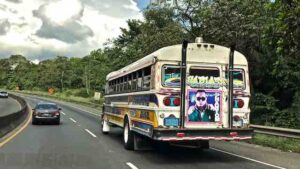
We also saw several “Diablos Rojos” buses. These are former school buses. They are seen everywhere in Panama. The buses are decorated in bright colors and unusual designs. Locals use them for really cheap transportation. We were advised that “Gringos”, that would be us, might not be safe riding the Diablos Rojos. With that being the case we simply admired them from afar.
For the afternoon we were heading out to tour the locks at the Panama Canal. Carol and I have transited the canal twice during our cruise vacations.
I had seen some bad traffic in my time. Back in the day, but not so much anymore, Los Angeles had bad traffic. India has the most chaotic traffic that I have ever seen by a degree of several.
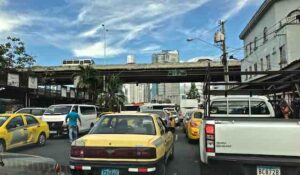
However, as of today Panama gets a #1 ranking in standstill traffic. We probably went a couple of miles in three hours. The traffic was so bad that we had to cancel today’s tour of the Panama Canal. We hope to try again tomorrow. It will be Saturday and we expect the traffic to decrease a good deal. The snarled mass of cars was so bad that when we were within two blocks of the hotel we decided to leave Camilo and WALK back to the hotel. That probably saved both him and us a lot of time. Yep. Panama is in first place for worst standstill traffic in my world.
I am a platinum member of the Starwood Guest Program. That gives me “status”. In the traveling world “status” is your friend.
As mentioned we have a complimentary outstanding buffet breakfast each morning. Our room package also comes with a complimentary “happy hour”. If I told you what we paid for our upgraded suite hotel room you wouldn’t believe me. Since that’s the case why tell you?
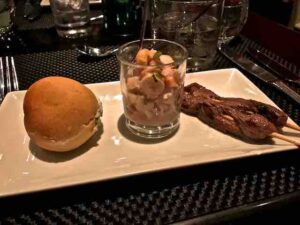
Our “happy hour” was served in an “opulent” setting. We had our choice of unlimited wine, beer and liquor. Then to top it off, after our drinks were served, they gave with a wide range of appetizers and desserts…at no charge. Starwood really knows how to treat their platinum guests.
Despite our deluxe “happy hour” we had our heart set on eating in a nice local restaurant. One of the very best things about foreign touring is eating in great restaurants.
We had not eaten any Italian food lately. The hotel concierge recommended a somewhat nearby eatery named La Strega Italian Cuisine and Lounge. It was a 4-5 block walk from the Le Meridian. Although the side walks were non-existent it was a pleasant evening with temps in the high 70s.
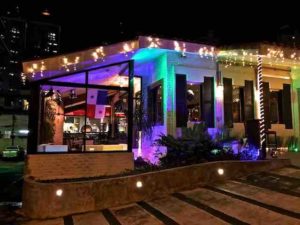
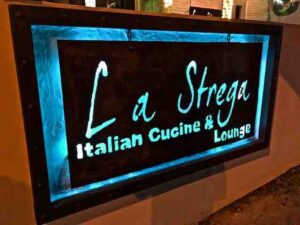
Our experience was La Strega could not have been better. The service was perfect. After eating and drinking at “happy hour” we ordered lightly. What is lightly? We split a pizza and some gourmet ravioli. We took half the pizza back to the room. Then we topped off our dining experience with a desert of a warm chocolate brownie and vanilla ice cream. Yes, I will go back on my specialized eating plan (Atkins – low carb) when I get home!
We’ve been noticing that the prices are most reasonable in Panama. They price everything in dollars and accept credit cards. That makes life simple.
The people of Panama have been very friendly as well. Everywhere we have gone people are smiling and seem genuinely happy to provide a nice experience for their touring visitors.
During the afternoon and dinner I had been texting back and forth to my various Panamanian race contacts. I didn’t use to have that international communication capability. One fellow, by the name of Alberto, had offered Carol and me complimentary pit passes for the race this weekend. What a nice gesture.
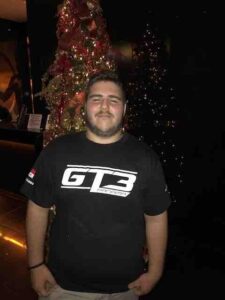
Alberto has spent all day at the track today. Nevertheless, he batted the horrendous traffic and drove into downtown to give us our tickets. Traffic delayed Alberto’s arrival until about 9 p.m. Nevertheless, he showed up in the lobby with a big smile on his face. I offered to treat him to a cocktail but he was dragging from being out in the sun all day at the Circuito Internacional de Panama. I’ll see Alberto on Sunday when we make our first appearance at the track.
Today the weather was hot but there was no rain. Some of our touring plans were upended by the traffic. Carol was still looking for postcards and stamps. Despite the heat and traffic it was still a good day.
Camilo was an excellent driver and guide. Alberto came through with the race tickets. We ate well. Even on a day where everything didn’t go as planned it was still a great day!
Saturday – December 3, 2016
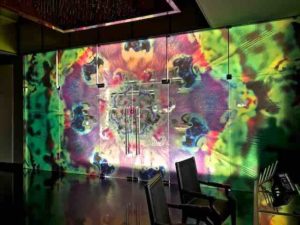
The Le Meridian hotel in downtown Panama City has an art deco design to it. The hotel is beautiful and well located. It’s nice having such a nice complimentary buffet breakfast at the hotel each morning. We can get in and out quickly. It’s also a plus not being charged the $19 per person breakfast expense as well. No, I couldn’t do this, or I couldn’t do this at the level I do it, without my sponsors.
It’s somewhat difficult to get in my daily exercise with the robust travel schedule I keep. This year I will travel overnight nearly 190 nights for the year. Nevertheless, I expect to meet my annual goal of exercising a minimum of 250 days aerobically.
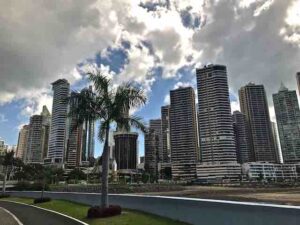
This morning I would take a four-mile power walk. This was a great way to see the Panamanian skyline up close. It was hot and sunny but there was no rain. I stopped off at a nearby indoor shopping mall. I was on the hunt for postcards. Carol sends the cards to friends and family all over the world. It’s her travel thing. It took some effort. Postcards are getting less and less available as we move further and further into the digital age. However, I kept trying and made a postcard score.
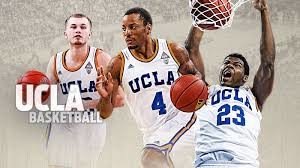
Once back at the hotel I “listened” to the UCLA basketball game. They were playing the #1 ranked Kentucky Wildcats in Lexington, Kentucky today. If I hadn’t come to Panama you probably would have been able to find me at Rupp Arena in the Bluegrass state for this game.
Two years ago the Bruins were losing to Kentucky at halftime 41-7! It didn’t get much better in the second half. Then last year UCLA upset the #1 ranked Wildcats. Today I could only see a “line score” that told me, on a nearly real time basis, which player scored or turned the ball over or whatever. Even with that limited form of communication it was exciting to “watch” the Bruins, an 11-point underdog, beat Kentucky for the second year in a row.
The game ended just in time for us to meet our driver Camilo for the day’s touring activity. The first stop was the Panama Canal. We had tried to come here yesterday but had to turn back when the traffic was at 100% gridlock.
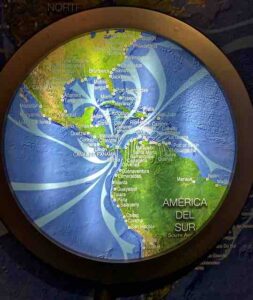
The Panama Canal connects the Pacific Ocean with Atlantic Ocean. It was built by the United States from 1904-1914. The United States owned and operated the canal until it was given back to Panama in 1999.
Carol and I have cruised through the Panama Canal on two different occasions. However, this was our first view of the canal from landside.
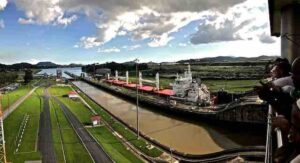
Camilo was telling us that ships are charged $200,000 and up for each one-way crossing. It must be worth it compared to sailing around South America or they wouldn’t do it. Just this past June a newer and bigger canal opened to handle larger ships at even bigger toll charges.
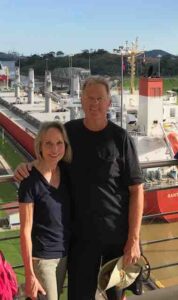
Today’s tour allowed us, at the Miraflores locks, to view the ships transiting the canal. Then there was the obligatory stop at the gift shop. They were selling a Panama license plate for $25 U.S. I bought my souvenir license plate yesterday from a street vendor for three dollars! We also toured the five-story Panama Canal museum and watched the movie depicting the canal’s long history. Overall, a very worthwhile visit and something that if you come to Panama is a mandatory stop.
One of the primary advantages of hiring your own personal driver on a trip like this is customization. We can stop when and where we want and for as long as we want. I think that advantage is priceless.
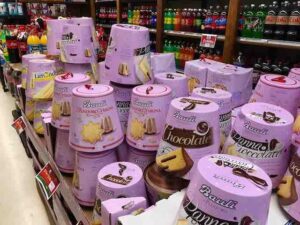
Carol wanted to pick up some Panamanian coffee for gifts for the folks back home. We stopped off at a local grocery store for that purpose. Camilo advised us on the best coffees to get. Carol, with postcards and coffee, was a happy camper.
I like doing as many diverse activities on these trips as I can. I want to see and do things that most people either wouldn’t think of, or if they did think of it wouldn’t have the courage or initiative to do.
With that being the case, I had asked Camilo if there were any local sporting events happening in Panama City today. It just turned out that the Panama country futbol (soccer) championship was happening tonight.
Camilo told me that the game was being played by teams from two of the lowest economic areas in all of Panama. Deportivo Arabe Unido would play Plaza Amador. He thought that if we could buy “preferential” tickets it would be safe for us gringos to attend.
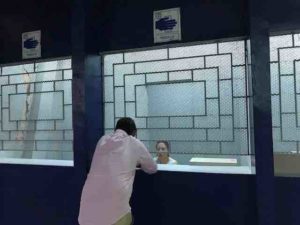
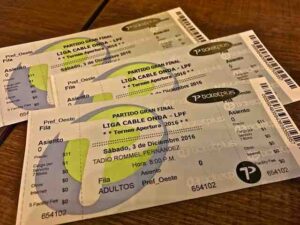
Off we went to the stadium to buy tickets to the match. Folks, Carol and I hang our hat most often at Angels Stadium to see the Los Angeles Angels of Anaheim play. ESPN’s fan survey has rated Angels Stadium as the #1 fan favorite of any stadium for the sports of baseball, football, basketball and hockey. Angels Stadium has got to be the safest and most comfortable place to watch a game of nearly any stadium you could visit.
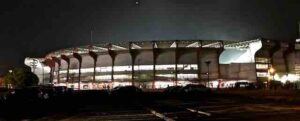
On the other hand today we were going to the Estadio Rommel Fernandez multi-purpose stadium. The venue was inaugurated on February 6, 1970. It was designed to accommodate the XI Central American and Caribbean Games.
The neighborhood wasn’t the best. Soccer as a sport has been noted for having problems with crowd control. Nevertheless, we marched up to the ticket window and bought three preferential tickets. They sold for $12 each. General admission tickets were eight bucks a pop.
We still had time for dinner. Camilo advised us that the stadium would not be good place to eat dinner. No, we were not going to Angels Stadium tonight.
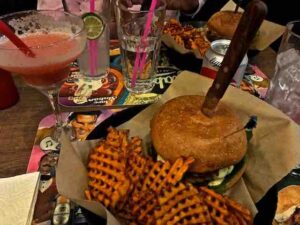
Camilo had a good idea in mind. He asked us if we liked hamburgers. Of course, we do. He had just the right place in mind, Slabon, a gourmet hamburger restaurant. The food was great at Slabons.
Now it was time to find a parking spot at the soccer match. It was dark by now. Maybe “pitch black” was a better way to describe where we were. There was really no “official” parking. It was all street parking. Cars were pulled up and over curbs and parked in every which direction. We circled the area at slow speeds until we found a spot. Now we had a two-block walk to the stadium.
Camilo led the way but kept looking back to make certain he still had a couple of gringos following him. The entire situation was rather chaotic. Most of the fans, predominantly male, were in their twenties.
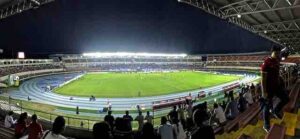
I was looking forward to keeping our tickets as a souvenir. However, the ticket taker tore off the small stub of the ticket and gave it back to us while keeping the much larger ticket for his “safe-keeping”. That was disappointing.
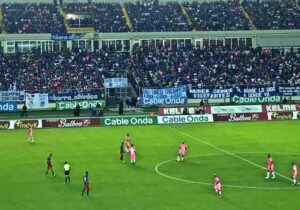
However, this simply pointed to the fact that I learned on my first ever international trip. We don’t go on these trips to have things be like they are at home. We don’t have to worry about that all that much. You can just about bet if you do something one way from where you come from they will do it nearly the opposite when you travel. Nevertheless, I really wanted that ticket as a souvenir.
The “pat down” process was something too. I felt like I had just entered federal prison and was meeting the new guards! It was all part of the experience.
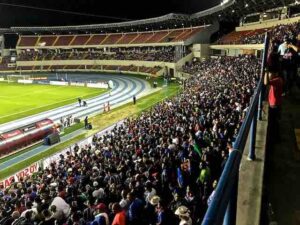
I hope you get the chance take a look at the page on my website titled, “My Sports Spectating Resume”. Up until tonight you will note I had never seen a high level professional soccer game or ANY soccer match where an admission was charged. Now that void has been erased. Here’s the link to the page I mentioned:
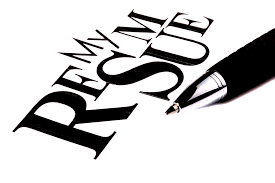
May I be frank with you? Thanks, I thought that would be O.K. I don’t get soccer. There, I’ve said it. I don’t get soccer. I watched my kids play it. I’ve seen a little bit on TV including the World Cup. Nevertheless, I don’t get soccer!!!
We went tonight for the adventure. During “halftime” I convinced Camilo to take Carol and me down to the concession stand just to see what the fans were buying. For the most part they were buying only beer.
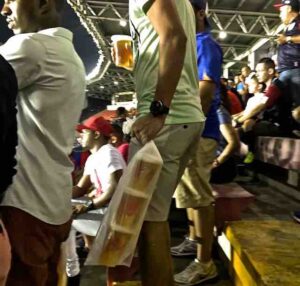
Fans could order three or four beers at a time. They would be stacked vertically on top of each other in plastic cups. The multiple beers were then placed in a long plastic sleeve so the recipient could take them back to their seats. Folks, whatever you are imagining after my description of this activity forget about it. You won’t even be close. Don’t miss the photos and video from the soccer match and the rest of the trip.
Midway during the game I asked Camilo if it would be O.K. if I moved from our somewhat remote seats into the heart of the crowd. He was a bit skeptical but gave me the O.K. Off I went. Yep. I am an adventuresome traveler.
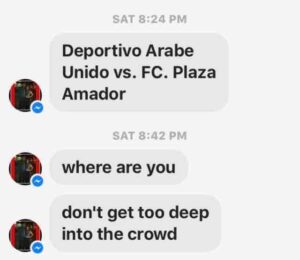
I wanted to get some crowd reaction. I wanted to get up close and personal. I was gone for about 15 minutes. Camilo sent me a text message. He was asking where I was and warning me not to go “too deep into the crowd”.
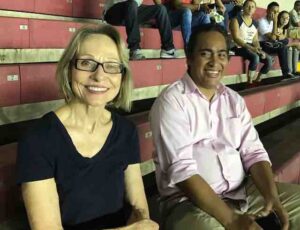
Given her druthers Carol would have recommended we bypass this soccer match entirely. On the other hand I considered it a highlight of the trip. I think Camilo was a little unbelieving as well. Once we were there we all had a good time.
To try to clarify the situation some I made these comments to Camilo. I told him, “I am not Panamanian. I don’t know anything about soccer. Despite that I want to experience a soccer match as a Panamanian would.” He understood.
On the way out of the contest, a “one-nil” thriller, Camilo offered this warning. “I told you to watch out for yourselves on the way in because there were so many people. Now I want you to watch out for yourselves because there aren’t very many people on the way back in the dark to the car”. That made perfect sense.
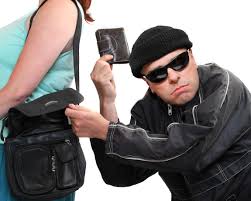
By the way for a moment I thought I had been pick-pocketed. I had been carrying a stack of twenty dollar bills in my back pocket. A simple button protected things. When I got into the stadium I felt the pocket for my money. The pocket was empty. About $200 was gone!
For about two minutes I was more than concerned. How was I going to pay Camilo? It was about this time that I remembered I had placed the money in my shirt pocket for extra safe keeping. Whew!
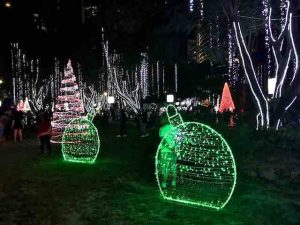
On the ride back to the hotel Camilo took a slight detour so we could see the festive Christmas lights in a nearby park. Yes, the benefits of having your own driver are many.
Sunday – December 4, 2016
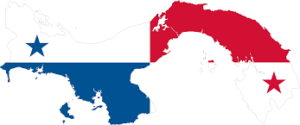
Today is race day! That’s right. I almost forgot that we had come to Panama with the idea of seeing a race. I have only been able to say on 73 mornings out of the nearly 25,000 mornings that I’ve been on this earth, “I’m seeing racing in a new country today!”
Camilo picked us up at 10 a.m. It would be a one-hour drive to the Circuito Internacional de Panama racetrack. The track opened up about a year and a half ago. I’ve been checking out Panama for the past 15 years waiting for this day.
Panama has ten provinces (states). The track is located in the province just to the west of Panama City in the town of La Chorrera. This is not to be confused with the famous Panama City slum area known as El Chorrillo (visited earlier in our trip).
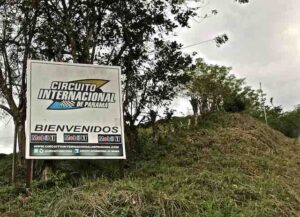
The last thirty minutes of the trip to the racetrack was over a pothole filled landscape. Camilo said it was what it might be like driving on the moon. He was correct.
Just when we arrived at 11 a.m., with motorcycles racing on the track, it began to rain. It has not rained on our trip until this point. They red-flagged the race and the bikes pulled off the track. The rain shower was very brief.
The sun was hot and the rain had made things more humid. When we pulled into the track they were checking everyone’s trunk. Outside food and beverage were not allowed. Again, just like at the soccer match they took our beautiful souvenir tickets and exchanged them for a wristband. Dang.
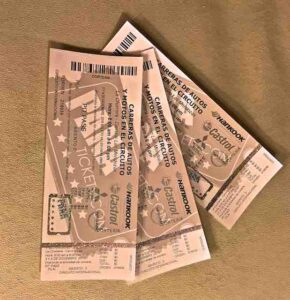
Speaking of tickets my new buddy Alberto Antonio Cordoba aka “GT3Panama” was responsible for our tickets today. Whenever I visit foreign countries I try to get as much information from locals as I possibly can. I never forget that I am a visitor and a guest in a new country to me. I rely on locals and their knowledge and caring for me to have a positive experience. That strategy has worked in every country I have ever visited.
Alberto stepped forward and provided us with complimentary pit passes. Today pit passes were selling for $50 U.S. each. The next highest priced ticket was the “V.I.P. Panoramic” ticket for thirty dollars. General admission, main straight, were $20 each. There was a pre-sale opportunity where tickets were offered at nearly 50% off.
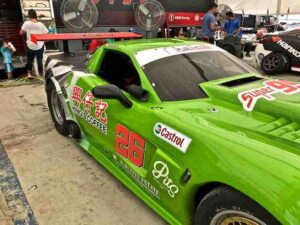
Soon we were in the pit area. At most road courses the “pit area” is called the “paddock”. However, today it was the pit area. Off we went to tour the pits.
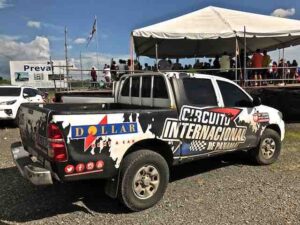
Remember one of my first contacts with Camilo had been when he told me he was interested in racing. He said that if I would cover his race ticket, gas money and refreshments he would drive us to and from the track. That sounded like a great deal for both him and me. As we continued to correspond I asked him to become more and more involved in our trip as both a driver and a tour guide. That first conversation turned into a great deal for everyone.
Alberto had delivered our race tickets to the hotel personally a couple of nights ago. He really went out of his way, after a full day at the racetrack, to do that. Gracias, Alberto!
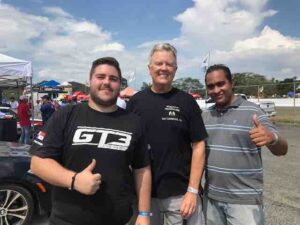
It wasn’t long before he and I spotted each other in the pits. It was fun to meet up and introduce Alberto (left) to Carol and Camilo (right). I’ve never met a friendlier person that Alberto.
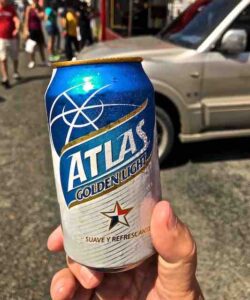
During the day we needed to hydrate. Both canned beer (Balboa Ice & Atlas Golden Light) and bottled water were two dollars each. We drank our share.
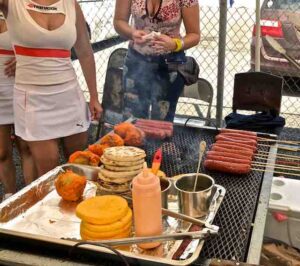
The food was good too. Check out those taters above. Whoa. I meant the potatoes! I ate at the Colombian food stand as did Carol. I had a potato concoction that was stuffed with meat and topped with salsa. Carol had a Colombian hot dog. It was sort of a normal hot dog but with toppings including cheese it looked more like a subway sandwich was it was served. Camilo chose some Panamanian meats and French Fries. All of the food was delicious.
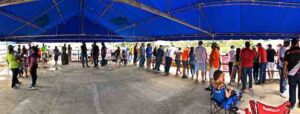
We could watch a little bit of the racing from some two-story elevated spectator viewing areas in the pit area. However, even from there we couldn’t see all winding in and out of sight racing.
There were several automobile racing classes. These included T2K, S2K, N2500, Super N, GT, GT1, GT2 and GTS. There were also two classes of motorcycles, 600 and 1,000cc.
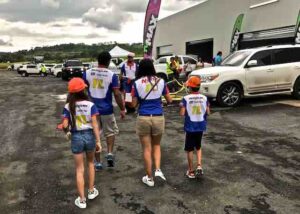
From what Alberto had told us each class would have two heat races. Yesterday had been reserved for practice and qualifications.
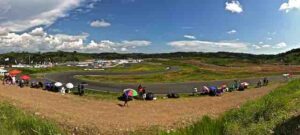
For the second round of heats we moved up to the “V.I.P. Panoramic” viewing area. From here we could see a great, how shall I say it, panoramic view of the track! We could also sit in a temporary grandstand area. A good deal of my video of the racing action comes from this spot at the track.
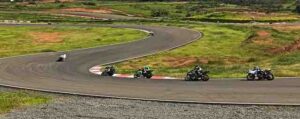
Although there was no more rain it was hot and humid all afternoon. We spent five hours at the track. By the end of the day we were tired. The motorcycle and the car racing had both been fun to watch.
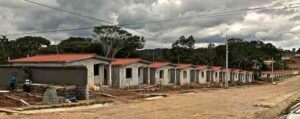
The La Chorrera area is growing by leaps and bounds. They are building tract homes like you wouldn’t believe. It sort of reminded me of the rows and rows of temporary housing I’ve seen during the oil boom in North Dakota. We stopped at one model home for a look see. Let me ask you this. Do you know ANYONE who has ever taken a foreign vacation trip and stopped for a model home tour?
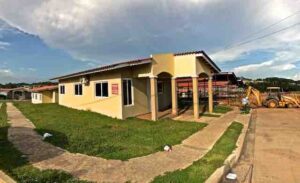
The model we saw was not decorated. The selling price was $89,000. The home was small, just 98 square meters or about 900 square feet. Of note, I grew up in a 660 square foot home for the first fifteen years of my life. This model home had three bedrooms and two baths. There was a kitchen and living room. With that layout you can accurately guess that the rooms were small. The house seemed over priced to me.
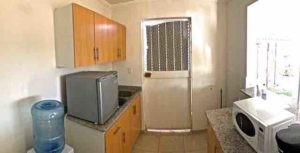
There were other neighborhoods of homes where the selling price was $39,000-49,000. If the small home we saw was $89,000 I can only imagine what homes costing half that would have been like. Nevertheless, it was an interesting stop on the overall Panamanian tour.
On the way back to town I convinced Camilo to stop at McDonalds so we could all have ice cream sundaes. We used the Mickey D drive-thru just so I could tell you we did.
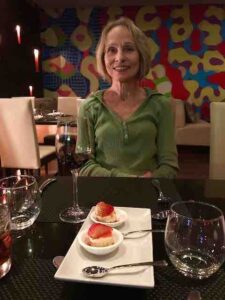
Once back at the hotel we relaxed for a bit. Then we went down for the complimentary (for Platinum guests) happy hour. We could drink as much of the hotel’s best liquor and appetizers as we could from 6-8 p.m.
We had our hearts set on dining at the La Posta restaurant. It was noted as one of Panama City’s best restaurants. Since it was located within 100 meters of our hotel it would be perfect. However, we learned they are closed on Sunday nights.
With that being the case we returned to the upscale Italian eatery we had enjoyed two nights ago. Let me be clear. I did not want to come back to this restaurant even though our experience had been A+ earlier. Why?
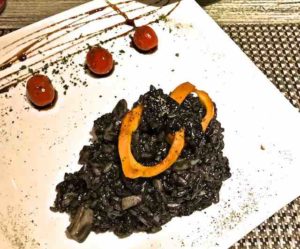
I’m all about trying new things. Yes, two nights ago we had a wonderful meal at this restaurant. However, if we went back there again I might be missing out on an equal or better experience tonight. That’s just how I view the world. Nevertheless, tonight was as good as two nights ago. We dined on black ink squid risotto and other delicacies.
After dinner we took a walking tour of a local park decorated to the hilt in Panamanian Christmas lights. The place was packed with families enjoying the festivities.
I hadn’t finished my four miles of power walking for the day yet. I dropped Carol at the hotel and went walking. I had passed by the Hilton Casino in my earlier walks. Tonight when I passed the gambling palace I thought I would quickly try my luck at the blackjack table. Wrong move!
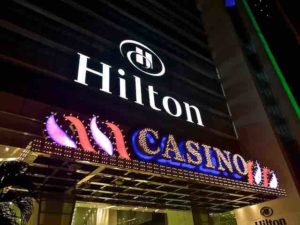
I figured I might was well go in and see what twenty dollars would get me. A quick double down hand and a little bit after that, crushing defeats of 20-19 and 19-18 found me out forty bucks.
Nevertheless, I could fall back on this quote: “It is not the critic who counts; not the man who points out how the strong man stumbles, or where the doer of deeds could have done them better. The credit belongs to the man who is actually in the arena, whose face is marred by dust and sweat and blood; who strives valiantly; who errs, who comes short again and again, because there is no effort without error and shortcoming; but who does actually strive to do the deeds; who knows great enthusiasms, the great devotions; who spends himself in a worthy cause; who at the best knows in the end the triumph of high achievement, and who at the worst, if he fails, at least fails while daring greatly, so that his place shall never be with those cold and timid souls who neither know victory nor defeat.”
Soon I was back to our hotel room with even more “story” to tell. Remember these trips are 100% about the “story”. They are all really only about the “story”. That has always been the case and will always be the case.
Monday – December 5, 2016
Today was get-a-way day. Our five-day trip to Panama was coming to an end. Our wakeup call came at 4:30 a.m. Panama time (1:30 a.m. San Clemente time). That would make for a somewhat long day by the time we went to bed at home tonight!
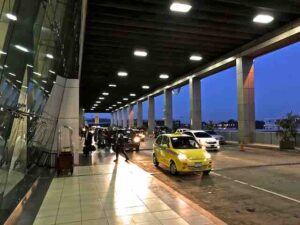
Camilo picked us up at the hotel at 5:15 a.m. The drive to the airport would take a bit less than thirty minutes. There was no traffic heading out of Panama toward the airport at that hour. However, traffic coming into the city on this work day was already beginning to build up.
We had arrived into Panama in the dark on Thursday. Now we were leaving in the dark on Monday. However, in between we had done a lot. We had toured all of Panama City, including the famous Panama Canal. We had seen the Panama country soccer championship game. We had stayed at a fabulous hotel and dined in some of the best restaurants. Oh….we went to an auto race as well.
We came away understanding that Panama City has a lot of traffic….but a lot of happy and friendly people too! We had made new friends. The weather, although somewhat hot and humid had cooperated with no rain heavy enough to use our windshield wipers. Overall, it had been another grand trip.
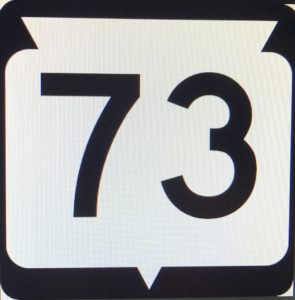
Trackchasing is a travel and logistics hobby that emanates with visits to auto racing facilities. Panama is the 73rd country where I have seen an auto race. No one comes close to matching that total.
When will I visit my next new country in search of life experiences and another auto race? If I told you I would be violating my oath to make each one of these trips a surprise for you. I will let you in on a little secret though. I’ll leave for country #74 in less than 24 hours after I return home from this trip!
We were flying standby on the way home. That was risky. With another major international trip that would having me leaving almost as soon as I returned home flying standby could be problematic. If we had not made a flight out of Panama today I would have been in a real pickle.
Nevertheless, we did make our flight. We had never flown on Copa Airlines before. Their non-stop flight would take us seven hours to get back to Los Angeles. That was just fine. We landed at LAX at about noon. We were back in San Clemente admiring the Pacific Ocean by 2 p.m. As we have done after returning from other foreign trips the first place we stopped was In N Out Burgers!
Another great adventure was in the record books.
Thanks for reading about my trackchasing,
Randy Lewis
World’s #1 Trackchaser
Randy is a freelance journalist who winters in San Clemente, California and sometime flies in coach.
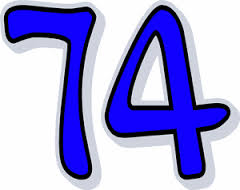
And so it goes from country #73. I hope you’ll tune in when country #74 becomes a reality. I don’t think you’ll have to wait to long. I’m planning to leave TOMORROW for #74!
THE COUNTRY LIST
#73!!
RLR – Randy Lewis Racing Lifetime Trackchasing Countries
# 1 – UNITED STATES OF AMERICA – Peoria Speedway – Mt. Hawley, (oval) – Track #1, Peoria, Illinois – circa 1954 (age 5)
# 2 – CANADA – Cayuga Speedway (oval) – Track #174, Nelles Corner, Ontario – July 31, 1988 (Dick Trickle winner)
# 3 – AUSTRALIA – Parramatta City Raceway (oval) – Track #180, Granville, New South Wales – November 17, 1989 (accompanied by Carol)
# 4 – UNITED KINGDOM – Northhampton International Raceway (oval) – Track #378, Northhampton – June 26, 1999 (accompanied by Carol, Kristy, Jim)
# 5 – NETHERLANDS – Driesum Racetrack (oval) – Track #839, Driesum – May 5, 2005 (accompanied by Roland Vanden Eynde)
# 6 – BELGIUM – Bellekouter oval (oval) – Track #841, Affligem – May 8, 2005 (accompanied by Roland Vanden Eynde)
# 7 – FRANCE – Circuit de Croix en Ternois (road course) – Track #843, Saint-Pol sur-Ternoise – May 8, 2005 (accompanied by Roland Vanden Eynde – 2nd new country in one day!)
# 8 – GERMANY – Nurburgring (road course) – Track #844, Nurburg – May 13, 2005 (accompanied by Carol, Roland Vanden Eynde)
# 9 – NEW ZEALAND – Western Springs Speedway (oval) – Track #1,134, Western Springs – December 26, 2006 (accompanied by Carol)
# 10 – MEXICO – Triovalo Bernardo Obregon (oval) – Track #1,281, Tiajamulco de Zuniga, Jalisco – October 14, 2007 (accompanied by Carol, J.J., Roger Ward)
# 11 – BARBADOS – Bushy Park Racing Circuit (road course) – Track #1,296, Bushy Park – December 9, 2007
# 12 – THAILAND – Bira Circuit (road course) – Track #1,300, Pattaya – January 19, 2008
# 13 – SOUTH AFRICA – Durban Grand Prix (road course) – Track #1,315, Durban, KwaZulu-Natal – February 24, 2008 (accompanied by J.J. and Will Van Horne)
# 14 – JAMAICA – Dover Raceway (road course) – Track #1,322, Brown’s Town St. Ann – March 24, 2008
# 15 – SWEDEN – Sturup Raceway (road course) – Track #1,335, Malmo – May 10, 2008 (accompanied by Carol)
# 16 – DENMARK – Ring Djursland (road course) – Track #1,336, Tirstrup – May 11, 2008 (accompanied by Carol)
# 17 – CZECH REPUBLIC – Automotodrome BRNO (road course) – Track #1,381, Brno – September 13, 2008
# 18 – AUSTRIA – Lambrechten Stock Car Track (road course) – Track #1,382, Lambrechten – September 14, 2008
# 19 – IRELAND – Tipperary International Raceway (oval) – Track #1,388, Rosegreen – October 26, 2008 (Carol and I visited this track earlier in the year)
# 20 – GUYANA – South Dakota Circuit (road course) – Track #1,390, Timehri – November 2, 2008 (accompanied by Carol)
# 21 – CHINA – The Guia Circuit (road course) – Track #1,392, Macau – November 16, 2008 (accompanied by Carol)
# 22 – COSTA RICA – Autodromo La Guacima (road course) – Track #1,398, La Guacima – November 30, 2008
# 23 – ANDORRA – Grandvalira Circuit (road course) – Track #1,404, Port d’Envalira – January 17, 2009
# 24 – ARGENTINA – Circuito Efren Chemolli (oval) – Track #1,406, Buenos Aires – January 31, 2009 (shared with Jerry Fisher)
# 25 – QATAR – Losail International Circuit (road course) – Track #1,408, Doha – February 13, 2009
# 26 – BAHRAIN – Bahrain International Circuit (road course) – Track #1,410, Sakhir – February 27, 2009 (accompanied by Carol)
# 27 – UNITED ARAB EMIRATES – Dubai Autodrome (road course) – Track #1,411, Dubai – February 28, 2009 (accompanied by Carol)
# 28 – COLOMBIA – Autodromo de Tocancipa (road course) – Track #1,415, Tocancipa – March 22, 2009
# 29 – SPAIN – Motorland Aragon (road course) – Track #1,416, Alcaniz – March 28, 2009
# 30 – PORTUGAL – Circuto de Murca (road course) – Track #1,417, Murca – March 29, 2009
# 31 – ICELAND – Kapelluhraum (road course) – Track #1,420, Hafnafjorour – April 25, 2009 (shared with Will White)
# 32 – HUNGARY – Hungaroring (road course) – Track #1,426, Mogyorod – May 8, 2009 (accompanied by Carol)
# 33 – SWITZERLAND – Hock Ybrig (road course) – Track #1,427, Hoch Ybrig – May 9, 2009 (accompanied by Carol)
# 34 – ITALY – Vighizzolo d’Este Stock Car Track (road course) – Track #1,428, Vighizzolo d’Este – May 10, 2009 (accompanied by Carol)
# 35 – DOMINICAN REPUBLIC – Autodromo Mobil 1 (road course) – Track #1,515, Santo Domingo – December 6, 2009 (accompanied by Carol)
# 36 – MALTA – Ta’Qali Race Track (road course) – Track #1,521, Ta’Qali – February 7, 2010 (accompanied by Carol)
# 37 – FINLAND – Lake Pidisjarvi Ice Track (road course) – Track #1,524, Nivala – February 20, 2010
# 38 – JAPAN – Suzuka Circuit (road course) – Track #1,530, Suzuka – March 21, 2010
# 39 – CHILE – Autodromo de Interlomas (road course) – Track #1,531, Temuco – April 18, 2010
# 40 – MOROCCO – Circuit de Marrakesh (road course) – Track #1,535, Marrakesh – May 1, 2010 (accompanied by Carol)
# 41 – BRAZIL – Circuit de Caruaru – Aryten Senna (road course) – Track #1,540, Caruaru – May 16, 2010 (accompanied by Carol, Jerry Fisher and Katina Spencer)
# 42 – ESTONIA – Laitse Rally Park (road course) – Track #1,571, Laitse – July 24, 2010 (accompanied by Carol)
# 43 – LATVIA – Bikernieki (road course) – Track #1,572, Riga – July 25, 2010 (accompanied by Carol
# 44 – GUATEMALA – Autodromo Pedro Cofino (road course) – Track #1,580, Alotenango – August 15, 2010
# 45 – EL SALVADOR – El Jabali (road course) – Track #1,582, Quezaltepeque – August 22, 2010 (accompanied by Carol)
# 46 – ROMANIA – Bradu (road course) – Track #1,603, Bradu – October 16, 2010
# 47 – BULGARIA – Closed Route – Burgas (road course) – Track #1,604, Burgas – October 17, 2010 (accompanied by Lyubomir and Plamen Simeonov)
# 48 – SOUTH KOREA – Korea International Circuit (road course) – Track #1,605, Yeongam, Jeollanam-Do – October 24, 2010
# 49 – PHILIPPINES – Batangas Racing Circuit (road course) – Track #1,608, Batangas – November 21, 2010
# 50 – NORWAY – Lyngas Motorbane (road course) – Track #1,648, Lier – April 30, 2011
# 51 – MALAYSIA – Sepang International Circuit (road course) – Track #1,656, Sepang – May 28, 2011
# 52 – INDONESIA – Sentul International Circuit (road course) – Track #1,657, Babakan Madang, Boder – May 29, 2011
# 53 – LUXEMBOURG – Alzingen (road course) – Track #1,711, Alzingen – September 4, 2011 (accompanied by Carol)
# 54 – POLAND – Tor Slomczyn (road course) – Track #1,713, Slomczyn – September 11, 2011 (accompanied by Carol)
# 55 – SINGAPORE – Marina Bay (road course) – Track #1,714, Singapore – September 24, 2011 (accompanied by Carol)
# 56 – URUGUAY – Piriapolis Grand Prix (road course) – Track #1,724, Piriapolis – November 12, 2011
# 57 – SRI LANKA – Pannala Race Track (road course) – Track #1,732, Pannala – February 12, 2012
# 58 – ECUADOR – Autodromo Internacional de Yahuarcocha (road course) – Track #1,736, Ibarra – March 11, 2012
# 59 – SLOVAKIA – Slovakia Ring (road course) – Track #1,742, Orechova Puton – April 29, 2012
# 60 – MONACO – Circuit de Monaco (street course) – Track #1,746, Monte Carlo – May 13, 2012 (accompanied by Carol)
# 61 – CROATIA – Automotodrom Grobnik (road course) – Track #1,762, Rijeka – June 23, 2012
# 62 – PERU – Autodromo La Chutana (road course) – Track #1,802, Lima – October 21, 2012 (accompanied by Carol)
# 63 – GREECE – Serres Circuit (road course) – Track #1,807, Serres – November 4, 2012
# 64 – RUSSIA – Moscow Central Hippodrome (oval) – Track #1,824, Moscow – February 23, 2013 (accompanied by Carol)
# 65 – LITHUANIA – Marijampole Autokross Track (road course) – Track #1,842, Marijampole – May 12, 2013 (accompanied by Carol)
# 66 – INDIA – Buddh International Circuit (road course) – Track #1,915, Noida – October 27, 2013 (accompanied by Carol)
# 67 – GEORGIA – Rustavi International Motorpark (road course) – Track #1,916, Rustavi – November 10, 2013
# 68 – TRINIDAD AND TOBAGO – Larry Gomes Stadium (road course) – Track #1,928, Arima – January 26, 2014 (accompanied by Carol)
# 69 – TURKEY – Istanbul Park (road course) – Track #2,035 Akfirat (accompanied by Carol)
# 70 – AZERBAIJAN – Streets of Baku (road course) – Track #2,037, Baku (accompanied by Carol)
# 71 – SERBIA – Usce (road course) – Track #2,224, Belgrade (accompanied by Carol)
# 72 – BOZNIA AND HERZEBOVINA – Zaluzani (road course) – Track #2,235, Zaluzani (accompanied by Boris Miljevic)
# 73 – PANAMA – La Chorrera (road course) – Track #2,290, Circuito Internacional de Panama (accompanied by Carol)
The International Big 3.
- . Randy Lewis, San Clemente, California USA – 73
- . Roland Vanden Eynde, Vilvoorde, Belgium – 52
- . Carol Lewis, San Clemente, California USA – 41
2016 has been a great international trackchasing year. So far I racked up new country trackchasing visits to Serbia, Bosnia and Herzegovina and now Panama. I’m not done yet.
LIFETIME TRACKCHASER COMPARISONS
The three most important trackchasing comparisons to me are:
Total lifetime tracks seen
Total “trackchasing countries” seen
Lifetime National Geographic Diversity results
Total Lifetime Tracks
There are no trackchasers currently within 565 tracks of my lifetime total. Don’t blame me.
- . Randy Lewis, San Clemente, California – 2,290
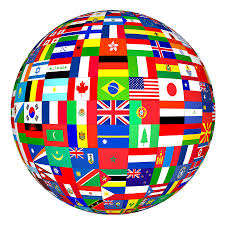
Total Trackchasing Countries
There are no trackchasers currently within 10 countries of my lifetime total.
- . Randy Lewis, San Clemente, California – 73
Current lifetime National Geographic Diversity results
- Randy Lewis, San Clemente, California – 4.47
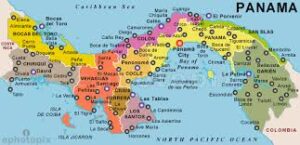
Panama – FAST FACTS*
Provided by my friends at Wikipedia
Panama officially called the Republic of Panama, is a country usually considered to be entirely in North America or Central America. It is bordered by Costa Rica to the west, Colombia (in South America) to the southeast, the Caribbean Sea to the north and the Pacific Ocean to the south. The capital and largest city is Panama City, whose metropolitan area is home to nearly half of the country’s 3.9 million people.
With the backing of the United States, Panama seceded from Colombia in 1903, allowing the Panama Canal to be built by the U.S. Army Corps of Engineers between 1904 and 1914. In 1977 an agreement was signed for the total transfer of the Canal from the United States to Panama by the end of the 20th century, which culminated on 31 December 1999.
Revenue from canal tolls continues to represent a significant portion of Panama’s GDP, although commerce, banking, and tourism are major and growing sectors.
There are several theories about the origin of the name “Panama”. Some believe that the country was named after a commonly found species of tree (Sterculia apetala, the Panama tree). Others believe that the first settlers arrived in Panama in August, when butterflies abound, and that the name means “many butterflies” in an indigenous language.
The best-known version is that a fishing village and its nearby beach bore the name “Panamá”, which meant “an abundance of fish”.
HISTORY
At the time of the arrival of the Spanish in the 16th century, the known inhabitants of Panama included the Cuevas and the Coclé tribes. These people have nearly disappeared, as they had no immunity from European infectious diseases.
When Panama was colonized, the indigenous peoples fled into the forest and nearby islands. Scholars believe that infectious disease was the primary cause of the population decline of American natives. The indigenous peoples had no acquired immunity to diseases, which had been chronic in Eurasian populations for centuries.
In 1671, the privateer Henry Morgan, licensed by the English government, sacked and burned the city of Panama – the second most important city in the Spanish New World at the time. In 1717 the viceroyalty of New Granada (northern South America) was created in response to other Europeans trying to take Spanish territory in the Caribbean region. The Isthmus of Panama was placed under its jurisdiction. However, the remoteness of New Granada’s capital, Santa Fe de Bogotá (the modern capital of Colombia) proved a greater obstacle than the Spanish crown anticipated as the authority of New Granada was contested by the seniority, closer proximity, and previous ties to the viceroyalty of Lima and even by Panama’s own initiative. This uneasy relationship between Panama and Bogotá would persist for centuries.
1800s
In the first 80 years following independence from Spain, Panama was a department of Colombia, after voluntarily joining it at the end of 1821. The people of the isthmus made several attempts to secede and came close to success in 1831, and again during the Thousand Days’ War of 1899–1902. When the Senate of Colombia rejected the Hay–Herrán Treaty, the United States decided to support the Panamanian independence movement.
In November 1903 Panama proclaimed its independence and concluded the Hay–Bunau-Varilla Treaty with the United States. The treaty granted rights to the United States “as if it were sovereign” in a zone roughly 16 km (10 mi) wide and 80 km (50 mi) long. In that zone, the U.S. would build a canal, then administer, fortify, and defend it “in perpetuity”. In 1914 the United States completed the existing 83-kilometre-long (52-mile) canal. The early 1960s saw the beginning of sustained pressure in Panama for the renegotiation of this treaty.
The US intention to influence the area, especially the Panama Canal’s construction and control, led to the separation of Panama from Colombia in 1903 and its establishment as a nation. The United States intensively encouraged the Panamanian separatist movement. From 1903 to 1968, Panama was a constitutional democracy dominated by a commercially oriented oligarchy. During the 1950s, the Panamanian military began to challenge the oligarchy’s political hegemony.
Arias Madrid was declared the winner of elections that were marked by violence and accusations of fraud against Alianza del Pueblo. On October 1, 1968, Arias Madrid took office as president of Panama, promising to lead a government of “national union” that would end the reigning corruption and pave the way for a new Panama. A week and a half later, on October 11, 1968, the National Guard (Guardia Nacional) ousted Arias and initiated the downward spiral that would culminate with the United States’ invasion in 1989. Arias, who had promised to respect the hierarchy of the National Guard, broke the pact and started a large restructuring of the Guard. To preserve the Guard’s interests, Lieutenant Colonel Omar Torrijos Herrera and Major Boris Martínez commanded the first military coup against a civilian government in Panamanian republican history.
The military justified itself by declaring that Arias Madrid was trying to install a dictatorship, and promised a return to constitutional rule. In the meantime, the Guard began a series of populist measures that would gain support for the coup.
Among them were:
Price freezing on food, medicine and other goods until January 31, 1969
rent level freeze
legalization of the permanence of squatting families in boroughs surrounding the historic site of Panama Viejo
Parallel to this, the military began a policy of repression against the opposition, who were labeled communists. The military appointed a Provisional Government Junta that was to arrange new elections. However, the National Guard would prove to be very reluctant to abandon power and soon began calling itself El Gobierno Revolucionario
Post-1970
During Omar Torrijos’s control, the military regime transformed the political and economic structure of the country by initiating massive coverage of social security services and expanding public education. The constitution was changed in 1972. For the reform to the constitution, the military created a new organization, the Assembly of Corregimiento Representatives, which replaced the National Assembly. The new assembly, also known as the Poder Popular (“Power of the People”), was composed of 505 members selected by the military with no participation from political parties, which the military had eliminated. The new constitution proclaimed Omar Torrijos the “Maximum Leader of the Panamanian Revolution”, and conceded him unlimited power for six years, although, to keep a façade of constitutionality, Demetrio B. Lakas was appointed president for the same period
In 1981 Torrijos died in a plane crash. Torrijos’ death altered the tone of Panama’s political evolution. Despite the 1983 constitutional amendments, which proscribed a political role for the military, the Panama Defense Forces (PDF), as they were then known, continued to dominate Panamanian political life. By this time, General Manuel Noriega was firmly in control of both the PDF and the civilian government.
Noriega’s regime had fostered a well-hidden criminal economy that operated as a parallel source of income for the military and their allies, providing revenues from drugs and money laundering. Toward the end of the military dictatorship, a new wave of Chinese migrants arrived on the isthmus in the hope of migrating to the United States. The smuggling of Chinese became an enormous business, with revenues of up to 200 million dollars for Noriega’s regime.
On the night of June 9, 1987, the Cruzada Civilista (“Civic Crusade”) was created and began organizing actions of civil disobedience. The Crusade called for a general strike. In response, the military suspended constitutional rights and declared a state of emergency in the country. On July 10, the Civic Crusade called for a massive demonstration that was violently repressed by the “Dobermans”, the military’s special riot control unit. That day, later known as El Viernes Negro (“Black Friday”), left six hundred people injured and another six hundred detained, many of whom were later tortured and raped.
United States President Ronald Reagan began a series of sanctions against the military regime. The United States froze economic and military assistance to Panama in the middle of 1987 in response to the domestic political crisis in Panama and an attack on the U.S. Embassy. Yet these sanctions did little to overthrow Noriega but instead severely damaged Panama’s economy. The sanctions hit the Panamanian population hard and caused the Gross Domestic Product (GDP) to decline almost 25% between 1987–1989
On February 5, 1988, General Manuel Antonio Noriega was accused of drug trafficking by federal juries in Tampa and Miami.
In April 1988, the U.S. President Ronald Reagan invoked the International Emergency Economic Powers Act, freezing Panamanian government assets in all U.S. organizations. In May 1989 Panamanians voted overwhelmingly for the anti-Noriega candidates. The Noriega regime promptly annulled the election and embarked on a new round of repression.
The United States government said Operation Just Cause, which commenced on December 20, 1989, was “necessary to safeguard the lives of U.S. citizens in Panama, defend democracy and human rights, combat drug trafficking, and secure the neutrality of the Panama Canal as required by the Torrijos–Carter Treaties” The U.S. reported 23 servicemen killed and 324 wounded, with Panamanian casualties estimated around 450. Described as a surgical maneuver, the action led to civilian deaths whose estimated numbers range from 400 to 4,000 during the two weeks of armed activities. This surgical maneuver represented the largest United States military operation to that date since the end of the Vietnam War.
The urban population, with many living below the poverty level, was greatly affected by the 1989 intervention. The economic damage caused by the intervention has been estimated to be between 1.5 and 2 billion dollars.
Geography
Panama is located in Central America, bordering both the Caribbean Sea and the Pacific Ocean, between Colombia and Costa Rica. Its location on the Isthmus of Panama is strategic. By 2000, Panama controlled the Panama Canal, which connects the Atlantic Ocean and the Caribbean Sea to the North of the Pacific Ocean.
Nearly 500 rivers lace Panama’s rugged landscape. Mostly unnavigable, many originate as swift highland streams, meander in valleys, and form coastal deltas. However, the Río Chagres, located in central Panama, is one of the few wide rivers and a source of enormous hydroelectric power.
Climate
Panama has a tropical climate. Temperatures are uniformly high—as is the relative humidity—and there is little seasonal variation. On a typical dry-season day in the capital city, the early morning minimum may be 24 °C (75.2 °F) and the afternoon maximum 30 °C (86.0 °F). The temperature seldom exceeds 32 °C (89.6 °F) for more than a short time. Temperatures are markedly cooler in the higher parts of the mountain ranges, and frosts occur in the Cordillera de Talamanca in western Panama.
Climatic regions are determined less on the basis of temperature than on rainfall, which varies regionally from less than 1,300 millimeters (51.2 in) to more than 3,000 millimeters (118.1 in) per year. Almost all of the rain falls during the rainy season, which is usually from April to December, but varies in length from seven to nine months. In general, rainfall is much heavier on the Caribbean than on the Pacific side of the continental divide. The annual average in Panama City is little more than half of that in Colón. Although rainy-season thunderstorms are common, the country is outside the hurricane belt.
Panama’s tropical environment supports an abundance of plants. Forests dominate, interrupted in places by grasslands, scrub, and crops. Although nearly 40% of Panama is still wooded, deforestation is a continuing threat to the rain-drenched woodlands. Tree cover has been reduced by more than 50% since the 1940s. Subsistence farming, widely practiced from the northeastern jungles to the southwestern grasslands, consists largely of corn, bean, and tuber plots. Mangrove swamps occur along parts of both coasts, with banana plantations occupying deltas near Costa Rica.
Politics
Panama’s politics take place in a framework of a presidential representative democratic republic, whereby the President of Panama is both head of state and head of government, and of a multi-party system. Executive power is exercised by the government. Legislative power is vested in both the government and the National Assembly. The judiciary is independent of the executive and the legislature.
For all people national elections are universal and mandatory for all citizens 18 years and older. National elections for the executive and legislative branches take place every five years. Presidential elections do not require a simple majority; out of the four last presidents only one, incumbent president Ricardo Martinelli, was elected with over 50% of the popular vote.
Political culture
In December 1989 the United States invaded Panama to depose the dictator Manuel Noriega. Since the U.S. invasion, and resulting end to the 21-year military dictatorship, Panama has successfully completed four peaceful transfers of power to opposing political factions. The political landscape is dominated by two major parties and many smaller parties, many of which are driven by individual leaders more than ideologies.
Foreign relations
The United States cooperates with the Panamanian government in promoting economic, political, security, and social development through U.S. and international agencies. Cultural ties between the two countries are strong, and many Panamanians come to the United States for higher education and advanced training.
Military
The Panamanian Public Forces are the national security forces of Panama. Panama is the second country in Latin America (the other being Costa Rica) to permanently abolish standing armies. Panama maintains armed police and security forces, and small air and maritime forces. They are tasked with law enforcement and can perform limited military actions.
Administrative divisions
Panama is divided into ten provinces with their respective local authorities (governors), which are divided into districts and corregimientos (townships) and has a total of ten cities. Also, there are five Comarcas (literally: “Shires”) populated by a variety of indigenous groups.
Provinces
- Bocas del Toro
- Chiriquí
- Coclé
- Colón
- Darién
- Herrera
- Los Santos
- Panamá
- West Panamá
- Veraguas
Regions
- Emberá
- Guna Yala
- Ngöbe-Buglé Comarca
- Kuna de Madugandí
- Kuna de Wargandí
Economy
According to the CIA World Factbook, as of 2012 Panama had an unemployment rate of 2.7%. A food surplus was registered in August 2008. On the Human Development Index, Panama ranked 60th in 2015. In recent years, Panama’s economy has experienced a boom, with growth in real gross domestic product (GDP) averaging over 10.4% in the 2006–2008 period. Panama’s economy has been among the fastest growing and best managed in Latin America. The Latin Business Chronicle predicted that Panama would be the fastest growing economy in Latin America during the five years period 2010–14, matching Brazil’s 10% rate.
Despite Panama’s upper-middle per capita GDP, it remains a country of stark contrasts. Perpetuated by dramatic educational disparities, over 25% of Panama’s population lived in national poverty in 2013 and 3% of the population lives in extreme poverty, according to latest reports by the World Bank.
Economic sectors
Panama’s economy, because of its key geographic location, is mainly based on a well developed service sector especially commerce, tourism, and trading. The handover of the Canal and military installations by the United States has given rise to large construction projects.
A project to build a third set of locks for the Panama Canal was overwhelmingly approved in referendum (with low voter turnout, however) on October 22, 2006. The official estimated cost of the project is US$5.25 billion. The canal is of major economic importance because it provides millions of dollars of toll revenue to the national economy and provides massive employment. Transfer of control of the Canal to the Panamanian government completed in 1999, after being controlled by the US for 85 years.
Panama as a tax haven
Since the early 20th century, Panama has gained a reputation worldwide for being a tax haven. In 2016, the release of the Panama Papers caused a huge global financial scandal.
Transportation
Panama is home to Tocumen International Airport, Central America’s largest airport. Additionally there are more than 20 smaller airfields in the country.
Panama’s roads, traffic and transportation systems are generally safe, though night driving is difficult and in many cases, restricted by local authorities. Traffic in Panama moves on the right, and Panamanian law requires that drivers and passengers wear seat belts. Highways are generally well-developed for a Latin American country.
Currently, Panama has modern buses known as Metrobuses, along with a Metro line. Formerly, the system was dominated by colorfully painted diablos rojos, with some remaining. A diablo rojo is usually “customized” or painted with bright colors, usually depicting famous actors, politicians or singers. Panama City’s streets experience frequent traffic jams due to poor planning for the now extensive private vehicle fleet.
Tourism
Panama City as seen from the Corredor Sur highway.
Tourism in Panama is rapidly growing. It has maintained its growth over the past five years due to government tax and price discounts to foreign guests and retirees. These economic incentives have caused Panama to be regarded as a relatively good place to retire in the world. Real estate developers in Panama have increased the number of tourism destinations in the past five years because of the interest for these visitor incentives.
Currency
The Panamanian currency is officially the balboa, fixed at a rate of 1:1 with the United States dollar since Panamanian independence in 1903. In practice Panama is dollarized: US dollars are legal tender and used for all paper currency, while Panama has its own coinage. Because of the tie to US dollars, Panama has traditionally had low inflation.
The balboa replaced the Colombian peso in 1904 after Panama’s independence. Balboa banknotes were printed in 1941 by President Arnulfo Arias. They were recalled several days later, giving them the name “The Seven Day Dollar”. The notes were burned by the new government, but occasionally balboa notes can be found in collections.
Demographics
Panama recorded a population of 3,405,813 in its 2010 census. The proportion of the population aged below 15 in 2010 was 29%. 64.5% of the population were aged between 15 and 65, with 6.6% of the population being 65 years or older.
More than half the population lives in the Panama City–Colón metropolitan corridor, which spans several cities. Panama’s urban population exceeds 70%, making Panama’s population the most urbanized in Central America.
Ethnic groups
In 2010 the population was 65% Mestizo (mixed white, Native American), 12.3% Native Americans, 9.2% Black/mulattoes and 6.7% White.
Languages
Spanish is the official and dominant language. The Spanish spoken in Panama is known as Panamanian Spanish. About 93% of the population speak Spanish as their first language, though many citizens who hold jobs at international levels, or who are a part of business corporations speak both English and Spanish. English is spoken by 8%, French by 4% and Arabic by 1%.
Largest cities
These are the 10 largest Panamanian cities and towns. Most of Panama’s largest cities are part of the Panama City Metropolitan Area.
| Nº | City | Population | Province |
| 1 | Panama City | 880,691 | Panamá |
| 2 | San Miguelito | 315,019 | Panamá |
| 3 | Tocumen | 103,177 | Panamá |
| 4 | David | 89,442 | Chiriquí |
| 5 | Las Cumbres | 89,000 | Panamá |
| 6 | Colón | 78,000 | Colón |
| 7 | La Chorrera | 68,896 | West Panamá |
| 8 | Pacora | 52,494 | Panamá |
| 9 | Santiago de Veraguas | 50,877 | Veraguas |
| 10 | Chitré | 46,191 | Herrera |
Religion
The government of Panama does not collect statistics on the religious affiliation of citizens, but various sources estimate that 75% to 85% of the population identifies itself as Roman Catholic and 15%–25% as Protestant. The Bahá’í Faith community of Panama is estimated at 2.00% of the national population, or about 60,000. The Church of Jesus Christ of Latter-day Saints (LDS Church) claim more than 40,000 members.
Education
Originally, during the 16th century, education in Panama was provided by Jesuit priests. Public education, as a national and governmental institution, began in 1903. The principles underlying this early education system were that children should receive different types of education in accordance with their social class and therefore the position they were expected to occupy in society.
Public education began in Panama soon after the separation from Colombia in 1903. The first efforts were guided by an extremely paternalistic view of the goals of education, as evidenced in comments made in a 1913 meeting of the First Panamanian Educational Assembly, “The cultural heritage given to the child should be determined by the social position he will or should occupy. For this reason education should be different in accordance with the social class to which the student should be related.” This elitist focus changed rapidly under United States influence.
In 2010, it was estimated that 94.1% of the population was literate (94.7% of males and 93.5% of females). Education in Panama is compulsory for the children of age group between 6 and 18. In recent decades, school enrollment at all levels, but especially at upper levels, has increased significantly.
Holidays and festivities
The Christmas parade, known as El desfile de Navidad, is celebrated in the capital, Panama City. This holiday is celebrated on December 25. The floats in the parade are decorated with the Panamanian colors, and the women dress in dresses called Pollera while the men dress in the traditional Montuno. In addition, the marching band in the parade, consisting of drummers, keeps the crowds entertained. In the city, a big Christmas tree is lit with Christmas lights, and everybody surrounds the tree and sings Christmas carols.
Traditional cuisine
Panamanian Cuisine is a mix of African, Spanish, and Native American techniques, dishes, and ingredients, reflecting its diverse population. Since Panama is a land bridge between two continents, it has a large variety of tropical fruits, vegetables and herbs that are used in native cooking.
Typical Panamanian foods are mild-flavored, without the pungency of some of Panama’s Latin American and Caribbean neighbors. Common ingredients are maize, rice, wheat flour, plantains, yuca (cassava), beef, chicken, pork and seafood.
Traditional clothing
Panamanian men’s traditional clothing consists of white cotton shirts, trousers and woven straw hat.
The traditional women’s clothing is the pollera. It originated in Spain in the 16th century, and by the early 1800s it was a typical in Panama, worn by women servants, especially wet nurses
Sports
The U.S. influence in Panama can be seen in the country’s sports. Baseball is Panama’s national sport and the country has regional teams and a national team that represents it in international events. At least 140 Panamanian players have played professional baseball in the United States, more than any other Central American country. Notable players include Bruce Chen, Rod Carew, Mariano Rivera, Carlos Lee, Manny Sanguillén, and Carlos Ruiz.
In boxing, four Panamanians are in the International Boxing Hall of Fame: Roberto Durán, Eusebio Pedroza, Ismael Laguna and Panama Al Brown.
Since the end of the 20th century, football has become a popular sport for Panamanians, the national league and the national team has featured a good progress.
Basketball is popular in Panama. There are regional teams as well as a squad that competes internationally. Two of Panama’s prominent basketball players are Rolando Blackman, a four-time NBA All-Star, and Kevin Daley, a 10-year captain and showman of the Harlem Globetrotters.
Long jumper Irving Saladino became the first Panamanian Olympic gold medalist in 2008. In 2012 eight different athletes represented Panama in the London 2012 Olympics.
That’s all folks! Official end of the RLR – Randy Lewis Racing Trackchaser Report
The complete trip including racing action from Panama
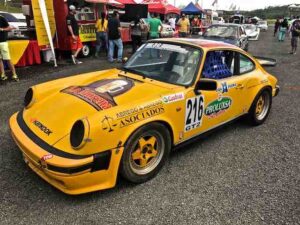
Click on the link below
The complete trip from the Panama Canal to the racing at the Circuito Internacional de Panama
[/tab]
[/tabs]


8 comments
Hello Randy,
My wife and I will be spending 5 days in Panama City(staying at Le Meridien Panama from 08/28-09/02) Curious if Camillo is still a driver you recommend. Blogs and info online suggests a taxi or driver when visiting Colon. Do you also recommend the Train from Panama City to Colon? Thanks on advise for our stay.
Hello Antonio, Yes! I still recommend Camilo. I don’t really know much about the train trip you are considering. However, here is Camilo’s contact info. Tell him “Randy..the trackchaser from California” sent you and I’m sure you will be treated well.
Email is camilobermudez05@gmail.com
Phone is +50769010678
All the best,
Randy
17-AUG.-2019
Reading through you message about the trip to Rep. of Panama, I was looking for tips on where to stay on layover between connecting flights.
If a green-card holder friend comes along, to stay at the recommended hotel
Le Meridian) may be a complication since a transit-visa is valid for only nine hours there (according to other sources).
It appears that hotels are not able to access that market when a passenger
cannot leave the airport. They really need to lengthen transit-visa pass time periods.
Otherwise, it was an interesting read.
Hi Michael, I agree transit visas can be limiting. On the one hand, they are trying to give the traveler a break by not having the transit passenger have to get a visa. On the other hand, if the passenger stays too long (as judged by the local country) those passengers are then required to get, and often pay for, a visa. Glad you enjoyed what I shared. Randy
We are two older women who will be in Panama City from April 16 (arriving at 8:00 a.m. and returning on April 28. We will only be in Panama City from April 16 to April 21 but we are looking for a driver who can take us around. We also need one to take us to Colon. You mentioned you had a great driver. Can you please send me information on the driver.
I get a lot of requests on this subject. Camillo was my driver. Here is his contact info: camilobermudez05@gmail.com
Phone: +50769010678. He’s a good guy. Tell him I sent you! :)
I am leaving for Panama Saturday. Get there 2 am on Sunday. I will be by myself. Thing I will hang in airport until sunrise and catch bus into town. My stay in old town. I will be there for carnival. The biggest information I got from you trip is vehicle traffic. I will try to stay away from that. Like to see canal, rain forest, old town, carnival. Will be there 96 hours. Thanks for the information. Mark. ps My retirement dream is to follow Formula 1 racing for an entire season. I am not a big fan really although I like racing too. Main thing is to see all the countries.
Mark, You’ll have fun in Panama. Old town will be a great place to stay. Best, Randy